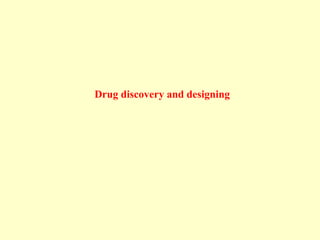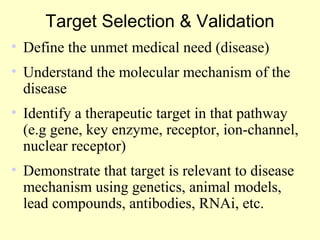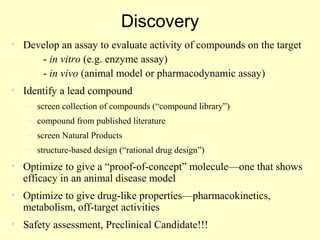Bioinformatics
- 1. Drug discovery and designing
- 2. Drug Candidate safety testing Animal Studies - relevant species - transgenic KO/KI mice - conditional KOs - agonists/antagonists - antibodies - antisense - RNAi Studies of Disease Mechanisms Human Studies Phases I,II, III Target -receptor; -ion channel; -transporter; -enzyme; - signalling molecule Lead Search -Develop assays (use of automation) -Chemical diversity -Highly iterative processMolecular Studies The Drug Discovery Process Lead optimization -selectivity -efficacy in animal models -tolerability: AEs mechanism- based or structure-based? -pharmacokinetics -highly iterative process Drug Approval and Registration Target selection & validation Discovery Development
- 3. Target Selection & Validation • Define the unmet medical need (disease) • Understand the molecular mechanism of the disease • Identify a therapeutic target in that pathway (e.g gene, key enzyme, receptor, ion-channel, nuclear receptor) • Demonstrate that target is relevant to disease mechanism using genetics, animal models, lead compounds, antibodies, RNAi, etc.
- 4. Discovery • Develop an assay to evaluate activity of compounds on the target - in vitro (e.g. enzyme assay) - in vivo (animal model or pharmacodynamic assay) • Identify a lead compound – screen collection of compounds (“compound library”) – compound from published literature – screen Natural Products – structure-based design (“rational drug design”) • Optimize to give a “proof-of-concept” molecule—one that shows efficacy in an animal disease model • Optimize to give drug-like properties—pharmacokinetics, metabolism, off-target activities • Safety assessment, Preclinical Candidate!!!
- 5. Development Pharmaceutical R&D Formulation Clinical Investigator & patient Clinical Pharmacology Clinical Research Statistics & Epidemiology Data Coordination Research Information Systems Information Services Regulatory Affairs Project Planning & Management Marketing Process R&D Chem Eng. R&D Manufacturing Bio Process R&D Safety Assessment Toxicology Drug Metabolism (ADME) Pharmacology Pre-Clinical Clinical
- 6. Clinical Trials Product Profile Marketing SOIProduct Profile Marketing SOI Information Learned 1. Absorption and metabolism 2. Effects on organs and tissue 3. Side effects as dosage is increased Information Learned 1. Effectiveness in treating disease 2. Short-term side effects in health -impaired patients 3. Dose range Information Learned 1. Benefit/risk relationship of drug 2. Less common and longer term side effects 3. Labeling information Compassionate Use Phase II Several hundred health-impaired patients Treatment Group Control Group Phase III Hundreds or thousands of health- impaired patients Investigational New Drug application IND Phase I 20 - 100 healthy volunteers take drug for about one month Remote data entry
- 7. Clinical Trials Continued APPROVAL PROCESS (Ex. FDA) Reviews, comments, and discussions Drug Co./Regulatory liaison activities APPROVAL Submit to Regulatory Agencies Advisory Committee Regulatory Review Team New Drug Application (NDA) Worldwide Marketing Authorization (WMA) in other countries
- 8. Drug Discovery—Convergence of Disciplines Patent Law Combinatorial Chemistry Synthetic Chemistry Physical Chemistry Physiology Biochemistr y DMP K Enzymology Immunolog y Pharmacology Information Technology Modelling Physiolog y Safety Assessment Metabolism Pharmacology Pathology Behavior Novel Molecule Intellectual Property Structural Activity Pharmacokinetic Properties In Vivo activity Safety Design Pharmaco - dynamics Physiology Physiology Physiology
- 9. Important Points in Drug Design based on Bioinformatics Tools History of Drug/Vaccine development – Plants or Natural Product • Plant and Natural products were source for medical substance • Example: foxglove used to treat congestive heart failure • Foxglove contain digitalis and cardiotonic glycoside • Identification of active component – Accidental Observations • Penicillin is one good example • Alexander Fleming observed the effect of mold • Mold(Penicillium) produce substance penicillin • Discovery of penicillin lead to large scale screening • Soil micoorganism were grown and tested • Streptomycin, neomycin, gentamicin, tetracyclines etc. http://www.geocities.com/bioinformaticsweb/drugdiscovery.html
- 10. Important Points in Drug Design based on Bioinformatics Tools • Chemical Modification of Known Drugs – Drug improvement by chemical modification – Pencillin G -> Methicillin; morphine->nalorphine • Receptor Based drug design – Receptor is the target (usually a protein) – Drug molecule binds to cause biological effects – It is also called lock and key system – Structure determination of receptor is important • Ligand-based drug design – Search a lead ocompound or active ligand – Structure of ligand guide the drug design process
- 11. Important Points in Drug Design based on Bioinformatics Tools • Identify Target Disease – Identify and study the lead compounds – Marginally useful and may have severe side effects • Refinement of the chemical structures – Detect the Molecular Bases for Disease – Detection of drug binding site – Tailor drug to bind at that site – Protein modeling techniques – Traditional Method (brute force testing)
- 13. Overview Continued – A simple example Protein Small molecule drug
- 14. Overview Continued – A simple example Protein Small molecule drug Protein Protein disabled … disease cured
- 15. Chemoinformatics ProteinSmall molecule drug Bioinformatics •Large databases •Large databases
- 16. Chemoinformatics ProteinSmall molecule drug Bioinformatics •Large databases •Not all can be drugs •Large databases •Not all can be drug targets
- 17. Chemoinformatics ProteinSmall molecule drug Bioinformatics •Large databases •Not all can be drugs •Opportunity for data mining techniques •Large databases •Not all can be drug targets •Opportunity for data mining techniques
- 18. Important Points in Drug Design based on Bioinformatics Tools • Application of Genome – 3 billion bases pair – 30,000 unique genes – Any gene may be a potential drug target – ~500 unique target – Their may be 10 to 100 variants at each target gene – 1.4 million SNP – 10200 potential small molecules
- 19. Important Points in Drug Design based on Bioinformatics Tools • Detect the Molecular Bases for Disease – Detection of drug binding site – Tailor drug to bind at that site – Protein modeling techniques – Traditional Method (brute force testing) • Rational drug design techniques – Screen likely compounds built – Modeling large number of compounds (automated) – Application of Artificial intelligence – Limitation of known structures
- 20. Important Points in Drug Design based on Bioinformatics Tools • Refinement of compounds – Refine lead compounds using laboratory techniques – Greater drug activity and fewer side effects – Compute change required to design better drug • Quantitative Structure Activity Relationships (QSAR) – Compute functional group in compound – QSAR compute every possible number – Enormous curve fitting to identify drug activity – chemical modifications for synthesis and testing. • Solubility of Molecule • Drug Testing
- 21. Drug Discovery & Development Identify disease Isolate protein involved in disease (2-5 years) Find a drug effective against disease protein (2-5 years) Preclinical testing (1-3 years) Formulation Human clinical trials (2-10 years) Scale-up FDA approval (2-3 years) FileIND File N DA
- 22. Techology is impacting this process Identify disease Isolate protein Find drug Preclinical testing GENOMICS, PROTEOMICS & BIOPHARM. HIGH THROUGHPUT SCREENING MOLECULAR MODELING VIRTUAL SCREENING COMBINATORIAL CHEMISTRY IN VITRO & IN SILICO ADME MODELS Potentially producing many more targets and “personalized” targets Screening up to 100,000 compounds a day for activity against a target protein Using a computer to predict activity Rapidly producing vast numbers of compounds Computer graphics & models help improve activity Tissue and computer models begin to replace animal testing
- 23. 1. Gene Chips • “Gene chips” allow us to look for changes in protein expression for different people with a variety of conditions, and to see if the presence of drugs changes that expression • Makes possible the design of drugs to target different phenotypes compounds administered people / conditions e.g. obese, cancer, caucasian expression profile (screen for 35,000 genes)
- 24. 2. High-Throughput Screening Screening perhaps millions of compounds in a corporate collection to see if any show activity against a certain disease protein
- 25. 2.High-Throughput Screening • Drug companies now have millions of samples of chemical compounds • High-throughput screening can test 100,000 compounds a day for activity against a protein target • Maybe tens of thousands of these compounds will show some activity for the protein • The chemist needs to intelligently select the 2 - 3 classes of compounds that show the most promise for being drugs to follow-up
- 26. 3. Computational Models of Activity • Machine Learning Methods – E.g. Neural nets, Bayesian nets, SVMs, Kahonen nets – Train with compounds of known activity – Predict activity of “unknown” compounds • Scoring methods – Profile compounds based on properties related to target • Fast Docking – Rapidly “dock” 3D representations of molecules into 3D representations of proteins, and score according to how well they bind
- 27. 4. Combinatorial Chemistry • By combining molecular “building blocks”, we can create very large numbers of different molecules very quickly. • Usually involves a “scaffold” molecule, and sets of compounds which can be reacted with the scaffold to place different structures on “attachment points”.
- 28. 4. Combinatorial Chemistry Issues • Which R-groups to choose • Which libraries to make – “Fill out” existing compound collection? – Targeted to a particular protein? – As many compounds as possible? • Computational profiling of libraries can help – “Virtual libraries” can be assessed on computer
- 29. 5. Molecular Modeling • 3D Visualization of interactions between compounds and proteins • “Docking” compounds into proteins computationally
- 30. 5.3D Visualization • X-ray crystallography and NMR Spectroscopy can reveal 3D structure of protein and bound compounds • Visualization of these “complexes” of proteins and potential drugs can help scientists understand the mechanism of action of the drug and to improve the design of a drug • Visualization uses computational “ball and stick” model of atoms and bonds, as well as surfaces • Stereoscopic visualization available
- 31. “Docking” compounds into proteins computationally
- 32. 6. In Vitro & In Silico ADME models • Traditionally, animals were used for pre-human testing. However, animal tests are expensive, time consuming and ethically undesirable • ADME (Absorbtion, Distribution, Metabolism, Excretion) techniques help model how the drug will likely act in the body • These methods can be experemental (in vitro) using cellular tissue, or in silico, using computational models
- 33. Size of databases • Millions of entries in databases – CAS : 23 million – GeneBank : 5 million • Total number of drugs worldwide: 60,000 • Fewer than 500 characterized molecular targets • Potential targets : 5,000-10,000
Editor's Notes
- #4: Here is what we are trying to achieve (refer to slide). Note that you can comment on: We conduct basic animal health research in RY, but our animal health care products are marketed by Merial, a joint venture between Merck and Rhone- Poulenc (note that RP is now known as Aventis (RP merged with Hoechst). Outcomes research is when we attempt to prove that our compounds not only cause important chemical effects in the body (such as reduced blood pressure or reduced cholesterol), but that these effects lead to reduced morbidity and mortality over time. The Zocor 4S study is an example. The research budget for MRL is $2.4 billion this year.
- #5: Here is what we are trying to achieve (refer to slide). Note that you can comment on: We conduct basic animal health research in RY, but our animal health care products are marketed by Merial, a joint venture between Merck and Rhone- Poulenc (note that RP is now known as Aventis (RP merged with Hoechst). Outcomes research is when we attempt to prove that our compounds not only cause important chemical effects in the body (such as reduced blood pressure or reduced cholesterol), but that these effects lead to reduced morbidity and mortality over time. The Zocor 4S study is an example. The research budget for MRL is $2.4 billion this year.
- #16: Tropsha compares these. Let’s look at some of the comparisons he makes. Mutual similarity techniques.
































